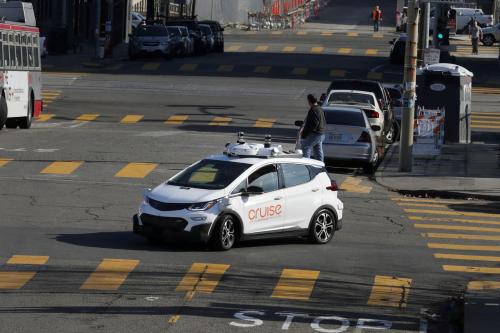At a recent Brookings forum, a civic leader from the San Francisco Bay Area remarked about that metro area’s chronic and well-known traffic problem. After all, the most prominent measure of metropolitan traffic congestion consistently identifies the Bay Area as having some of the worst conditions in the country. So it was an interesting coincidence that CEOs for Cities released a report that same day questioning those measures and suggesting – in fact, asserting – they are at best misleading and at worst inaccurate.
That measure, known as the Travel Time Index (TTI), is produced by the Texas Transportation Institute as part of its regular Urban Mobility Study. That study is the one that appears on the front page of your regional paper almost every year, and ranks metro areas based on a range of traffic indicators. It is widely cited in reports, speeches, and analyses. We have used it on numerous occasions in our work here at Brookings.
The critique, by Joe Cortright, argues that comparing travel times during rush hour to other times of day misses a key element: the lengths of those trips. Compare Charlotte and Chicago. While the TTI regularly identifies Chicago as one of the worst performers, Cortright’s study shows that not only are traffic delays in these two metros nearly the same, the situation in Charlotte is actually much worse since Charlotte travelers spend much more time on their trip and are exposed to traffic for a much longer period of time. The rub, according to Cortright, is that by failing to account for travel distance, it misses a key component of metropolitan traffic: land use and development patterns.
In fact, Cortright turns the whole thing on its head. Places like Nashville, Oklahoma City, Birmingham, and Kansas City that rank ok by the TTI are actually the worst performers according to the CEOs for Cities study. Conversely, Miami, New York, Sacramento, and Chicago turn out to be not so bad after all. In other words, the emphasis here is on accessibility (more economic and social interaction) rather than mobility (more movement).
So what does this mean for our San Francisco colleague? That metro goes from having the fifth worst congestion according to TTI to the 34th according to Cortright. Does that mean traffic on the Bay Area just got a hell of a lot better? Certainly not, but by taking traffic out of its transportation box, using a range of measurements and indicators, and thinking instead about transportation as access to economic opportunity, we should have a better guide to future investments.

Commentary
Everything You Know About Traffic May be Wrong
October 4, 2010